Tales From the Wild Side
Winter 2022
Board of Directors
President Ilka Milne
Vice-President Mike Hammond
Secretary Gaby Emond
Treasurer Henry Van Ael
Committees
Newsletter Ilka Milne & Bob Saunders
Website Ilka Milne & Bob Saunders
Events Ilka Milne & Bob Saunders
Boardwalk Ahlan Johanson & Mike Hammond
Publicity Henry Miller & Ilka Milne
Stewardship Liaison Gaby Emond
Poetry Corner
Blizzard Linda Pastan
the snow
has forgotten
how to stop
it falls
stuttering
at the glass
a silk windsock
of snow
blowing
under the porch light
tangling trees
which bend
like old women
snarled
in their own
knitting
snow drifts
up to the step
over the doorsill
a pointillist’s blur
the wedding
of form and motion
shaping itself
to the wish of
any object it touches
chairs become
laps of snow
the moon could be
breaking apart
and falling
over the eaves
over the roof
a white bear
shaking its paw
at the window
splitting the hive
of winter
snow stinging
the air
I pull a comforter
of snow
up to my chin
and tumble
to sleep
as the whole
alphabet
of silence
falls out of the
sky
Blizzard William Carlos William
Snow:
years of anger following
hours that float idly down —
the blizzard
drifts its weight
deeper and deeper for three days
or sixty years, eh? Then
the sun! a clutter of
yellow and blue flakes —
Hairy looking trees stand out
in long alleys
over a wild solitude.
The man turns and there —
his solitary track stretched out
upon the world.

Night Sky
MESSIER 45 THE PLEIADES
Article by Fred Pugh
Messier 45, also known as the Pleiades or Seven Sisters, is an open star cluster found in the constellation Taurus. The best time to view the Pleiades is in the fall and winter when Taurus is high in the sky (figure 1). The cluster occupies 110 arc minutes or four moon widths in the sky, shines at magnitude 1.6 and is easily visible to the naked eye. Most of us see only five or six of the brightest stars with our naked eyes but some can see up to 12 stars. The best way to view the Pleiades is with binoculars or a very small telescope. The nine brightest stars are named for the seven sisters of Greek mythology, Sterope, Merope, Electra, Maia, Taygeta, Celaeno, Alcyone and their parents Atlas and Pleione (figure 2).
The Pleiades is 445 light years away and extends for approximately 8 light years. Even though we can see only a handfull of stars, there are over a thousand stars that are gravitationally bound within it’s borders. Many of the stars are low mass brown dwarfs which astronomers sometimes called failed stars because they lack the mass to jumpstart nuclear fusion. The cluster is dominated by the hot blue stars and is considered very young having formed only within the last 100 million years or so. The stars of the Pleiades will only be gravitationally bound for about another 250 million years and then will disperse due to interactions. The total mass of the star cluster is roughly 800 solar masses. There is an interstellar dust cloud surrounding the Pleiades that was thought to be left over from the formation of the cluster but it is now known that they are unrelated because the stars and the dust cloud have different velocities. The star cluster just happens to be passing through the dust cloud resulting in the formation of a reflection nebula. The structures within the nebulous regions have been created by magnetic fields.
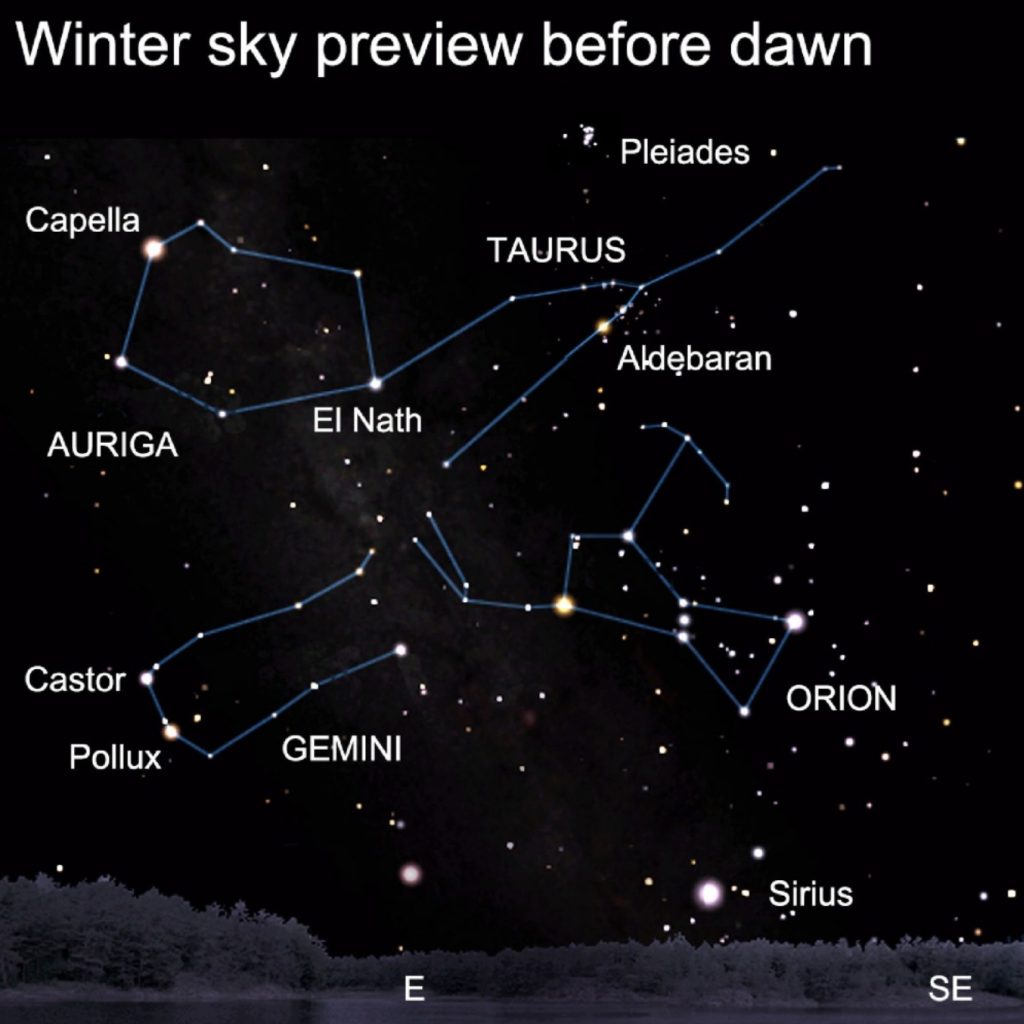
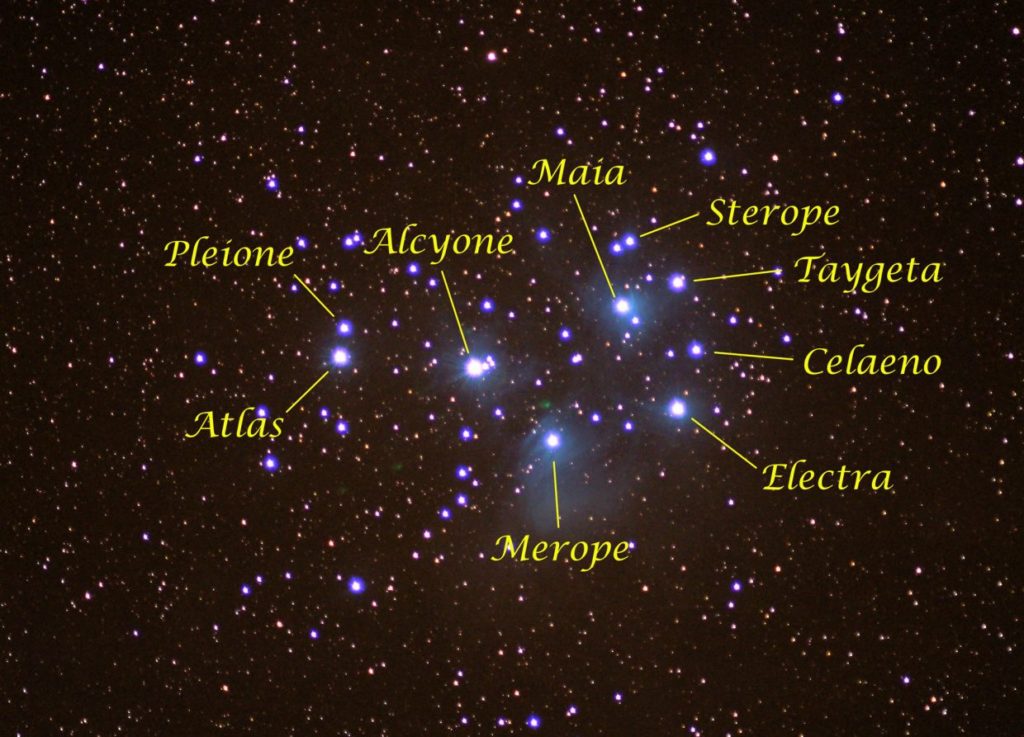
Pleiades is a relatively large star cluster so it is possible to to take nice photos without a telescope but a tracking mount will be necessary. (figures 3, 4). I took this photo (figure 5) of Pleiades or M45 on September 3, 2019 and was not happy with the result so recently I decided to go back and try a different approach in processing the data. It was very near to the new moon and the sky started out very good but shortly thereafter the Northern Lights began. Northern Lights wreak havoc when photographing deep sky objects as it is a form of light pollution and tends to show up in the photo as a very grainy, greenish mottling. This type of noise is very difficult to deal with and many times I have called it quits for the night because of Northern Lights. This particular night the Aurora seemed to come and go so I tried to stick it out and hope for the best. I took 20 shots of M45 but could only salvage 11 of the photos and even they were very difficult to process because of excess light pollution noise. This second try is an improvement over the original but there is still a strange mottling in the outer regions of the nebulosity in this photo. I am happy with the exposure time which has brought out a lot of structure in the nebulosity but my 5.1 inch telescope unfortunately does not have a field of view that wide enough to capture the entire scene. A smaller telescope would be better for this object. I will definitely re-visit the Pleiades on a better night.

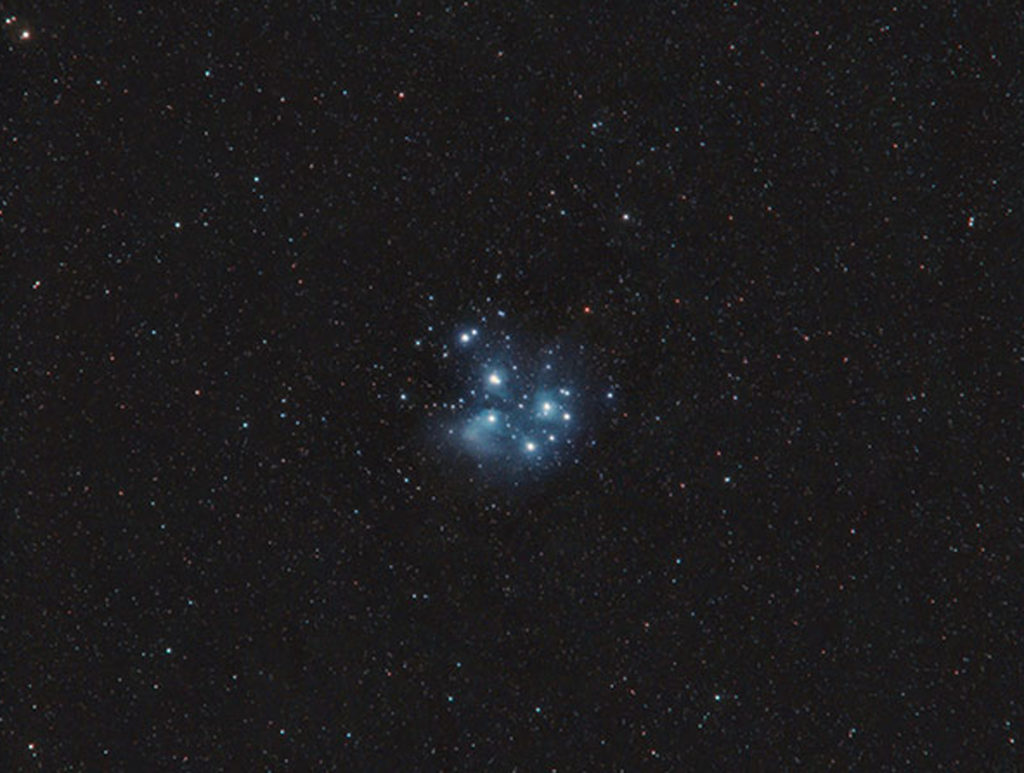
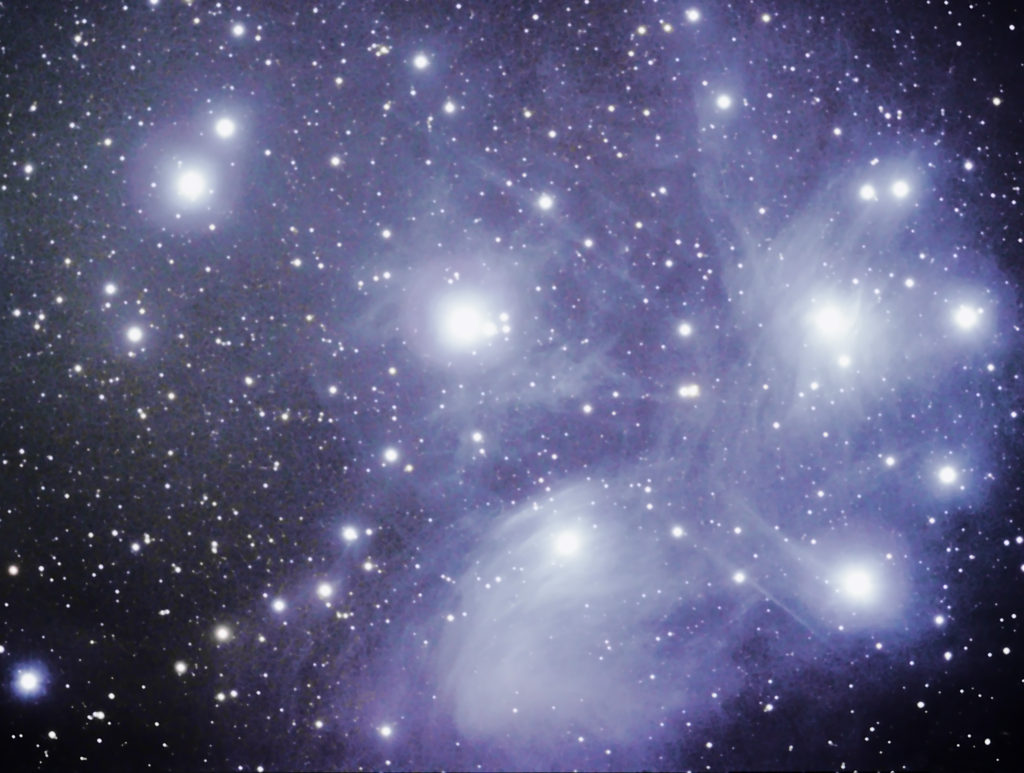
My work flow for creating this photo is as follows:
Telescope – Stellarvue SVA130T 5.1” Apochromatic Refractor
Focal length – 650mm
Focal ratio – f5
Camera – SBIG STF 8300C
Camera Temperature – set to -23C
Mount – Celestron CGEM DX
Light Frames – 11 at 5 minutes each
Dark Frames – 10 at 5 minutes each
Flat Frames – 10 at .01 second each
Dark Flat Frames – 10 at .01 second each
Inspected 20 light frames and discarded 9 frames because of Northern Light pollution
Converted all frames from RAW to FITS files
Stacked in deepskystacker to reduce noise and enhance signal
Imported into Photoshop to stretch data, smooth remaining noise, enhance color and sharpen
Clear skies
From the Homestead
Aaron Wenger has kindly offered to write column we are tentatively calling “From the Homestead”, a series of reminisces of the time he and his family spent living on Stamp Creek near the NorthWest Bay of Rainy Lake during the 70’s and 80’s. The original patent on the property (S ½ L6 C6) was taken out by George Stampe in 1916; Harry Blake acquired the kitty corner property (N ½ L5 C6) in the 1920’s and after George’s death, that property, as well. I’m not certain if the Stampe’s homesteaded the property or just maintained the property for wood cutting, but Harry did build a cabin near the mouth of the creek and lived there many years. Somewhere along the way the “e” from Stampe was dropped and the name of the creek became Stamp Creek.
After Harry’s death, Aaron and his wife Carol, along with Gary Trublood and his wife Sandy bought Harry’s properties, and built two uniquely-styled log cabins on the original Stampe property, with the help of Vance and Sallee Dyck, friends of Aaron’s, using some of the wood from Harry’s cabin. Eventually Vance and Sallee built a cabin on the property, as well, and later bought the property in the 1980’s, Aaron and Gary keeping the original Blake property at the mouth of the creek. Later they built a cabin there and still visit several times a year, although COVID has made that virtually impossible for the last two years. Some of Aaron’s stories are from his book “Hunting Stories”, soon to be published (movie rights are still being negotiated).
One of Aaron’s stories was published earlier in the Winter 2021 Newsletter.
Ice 101: Breakthrough
Aaron Wenger
Coming as we did from Ohio where an inch of ice was thick enough to skate on, or so we thought, the ice of Northwest Bay was an amazing surprise. We had never heard ice on a lake groan under a midwinter snow load. We had never guessed that a lake could have three feet of ice on it and still have standing water hidden under the snow. We learned.
She and me on our first trip up to the Bay, probably right around mid January, the trip introduced us to slush pockets out on a frozen landscape of ice and snow. We hadn’t built our log home yet, were just exploring that idea and the region. A friend who had fished NW Bay told us about this beautiful place with spruce trees defining a bay and ravens who performed daily. It was 1968, and we were young.
By late Winter of 1968-69 we had learned to cope with snowshoes and how to dress for the weather. So one weekend we took off to find 613 and NWB. Drove outta The Fort going West to Devlin, turned right and followed this nearly one lane road to a business called Northwest Bay Trading Post. Asked the owners, Joe and Leila, if we could park our Toyota there, pulled on snowshoes, headed down the creek that led to the Bay. It was likely still about ten below (F in those days yet). Beautiful walk along a rock cliff that framed the creek on the left and a couple of beaver houses on the right. There were no snow mobile tracks except just one where Joe used to go down the Bay to check on his “outpost camp” down there by the narrows. There were tracks in the snowmobile track that we assumed was a dog of Joe’s. Remember those old yellow SkiDos? That was his machine. You were lucky to have one run twenty miles without fouling a plug or worse, that’s why the bars serving the snowmachine crowd down in America were usually about ten miles apart. Break your machine down and you could likely make it to the next bar. Wide open those machines might make thirty (mph) and that wouldn’t be for long. They needed to be babied.
So we walked the machine track til we got out onto the real Bay. Then we split off cause we could see another bay opening up to the West that had some beautiful big spruce showing. I thought it might be the bay that my friend had fished. We got about to its mouth, actually it’s the mouth of Stamp Creek where just a few years later we would build our log home, but now in 1968 we had no idea of it being the bay of a creek.
As we got more into the opening with me leading, Carol gave out a little gasp and called my name. Looked back over my shoulder I saw her up to her knees in very wet snow, and sinking like the Titanic. Had no idea why, just that she was sinking, turned on my s’shoes and kinda floundered back best I could. Finally I saw that she was in a puddle of water and slush and that she had not broken through real ice. By going just a bit off to the side I was able to help pull her onto unbroken snow. I’m glad that there was no one to see us, we were scared.
Once out, of course, her clothes wet pretty much from waist down froze, I mean froze like a cast on your leg. We hobbled back a bit in the direction we had come from, realized that we weren’t gonna die, and stopped to collect our few feeble wits. We agreed:
not gonna drown
gonna be a hard walk back
ain’t anybody out here to make it better
time to grow up a little more
Carol was unhappy, but not panicked, certainly not in tears. This Ohio town girl has real stuff I understood, maybe more than me, I also started thinking how do we get back with one of us in a two legged cast. Kinda figured it out and started hammering on the frozen ice casts, breaking them along the knee lines where your leg has gotta bend to walk. Eventually understood that as bad as it looked, Carol was not especially wet under her clothes or in her Sorrels. We would make it. Also understood that we would not be running. Too cold and with maybe two miles to go, slow and steady would get us there. As we hobbled along I kept noticing more dog tracks, big dog tracks, wondered how many damn dogs does Joe have?
Well we got back, non the worse for wear, a bit more woods smart, and a lot more sure of what we had between us. Carol often told this story to relatives back in Ohio and would usually end the story by kinda exclaiming to them, “he came back for me!”. Damn right I did and I hope to always.
Gotta add a footnote: Joe had no dogs. This had been our introduction to sharing a world with fellow creatures of the North that a few years later would become our closest neighbors there among the creek, the beaver ponds, and the love in our log house.
Many Ways for Birds to Stay Warm in Winter
Henry Miller
Birds keep warm in many ways. Most birds migrate, of course, but the ones that remain here during the winter have developed various ways to keep warm. They must forage all day to find enough food to keep their body temperature a few degrees warmer than the air temperature. The thick layer of feathers provides effective insulation, especially when they fluff their feathers which traps the heat. They remain dry when it rains or snows because they coat their feathers with oil secreted by a gland at the upper base of the tail. Some birds have developed additional ways to keep from freezing. For example, Chickadees crowd into a hole in a tree sheltered from the wind and may dive into the snow if it is especially cold. On the coldest nights they will allow their body temperature to drop, entering a light hypothermia. Most birds during extreme cold spells roost in thick brush or some other shelter for a day or two. Some birds, such as Redpolls, can survive 20 hours without access to food in very cold temperatures. They are able to do so by packing their throat full of seeds and digesting those seeds slowly over that period. Many birds, especially Blue Jays and Canada Jays, stash food and eat it as winter progresses. Many birds also have a method of heat exchange that prevents their feet from freezing. Warm arterial blood coming from the heart warms up the colder blood from the feet and legs.
Nothing seems to bother Ravens. Often, they are seen circling around while a frigid wind (especially at -40) sends most wildlife into some kind of shelter.
The hole shown below was made by a Sharp-tailed Grouse, which spent the night under the snow to keep warm. (From the Fort Frances Times, January 10, 2022)
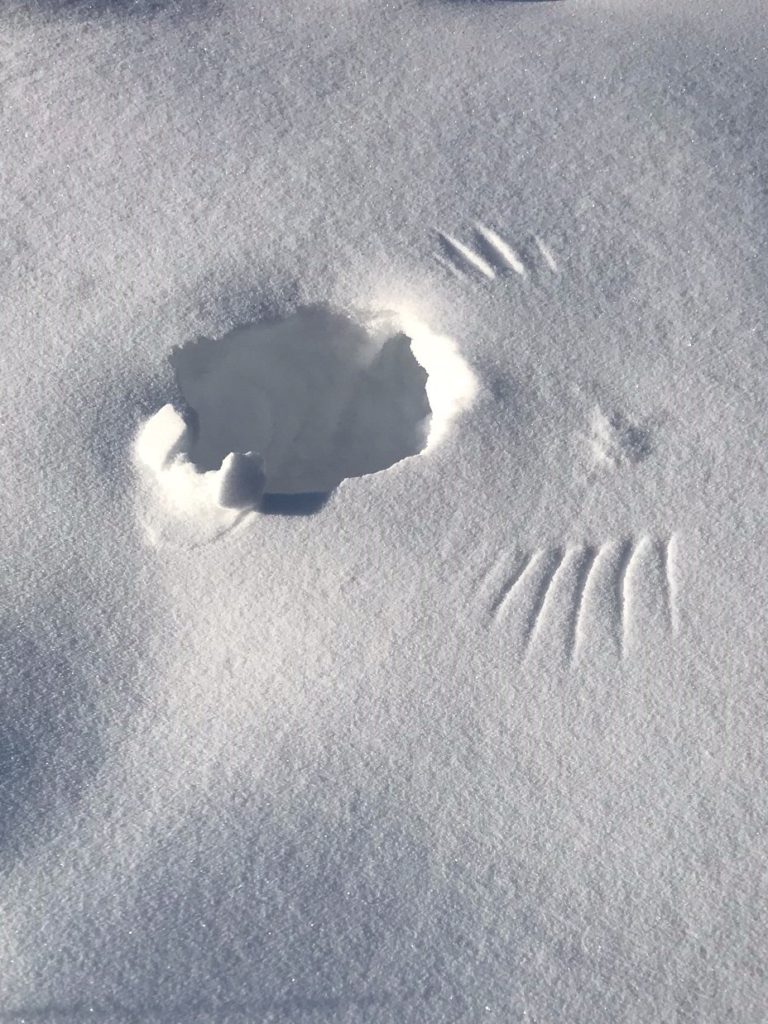
Peat Forest Skiing January 15
Peat forests are fascinating places but walking in them can be difficult in summer; winter, however, offers the perfect opportunity to travel unhindered through stunted Tamarack, Jack Pine, and Black Spruce, which dominates the forest. Well, not quite unhindered. Trail breaking can be brutal, but once the track has been established it is relatively to keep open. I have a large expanse of peat forest nearby and every year I make a game of making trails through the open forest, trying to create a line that weaves in and around the trees, without getting caught up in them and having to bushwhack my way through. I had planned to make this a club trip but once again Covid 19, this time the Omnicron variety, rose up and interfered with my plans.
But Henry and Ilka were keen to take a break from track skiing, and were able to join me for an enjoyable afternoon of skiing. We had a beautiful, mostly sunny day. At 7 am the temperature was a rather cool -36C but, remarkably, by the time we started it had risen to -8C, perfect for skiing. The mission that day was to find animal tracks and we did find signs of Bobcat, Otter, Snowshoe Hare, White-tail Deer, and Red (and possibly, Northern Flying) Squirrels. Birds were rather scarce – a couple Ravens, Chickadees, Redpolls, and a Ruffed Grouse. The highlight was three Sharp-tailed Grouse, that burst out of the snow, disturbing, as we did, a peaceful nap comfortably hidden in the snow. I’ve had Ruffed Grouse explode out of the snow next to me on numerous occasions, in fact, it has happened almost ever day this winter, and as much as I am used to it, I am startled every time. One of life’s little pleasures.
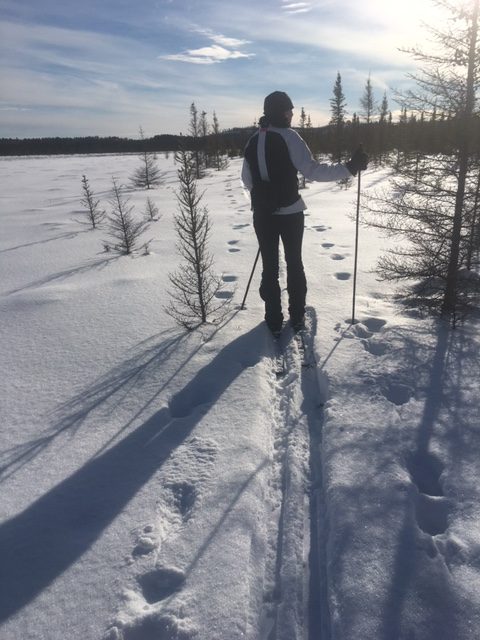

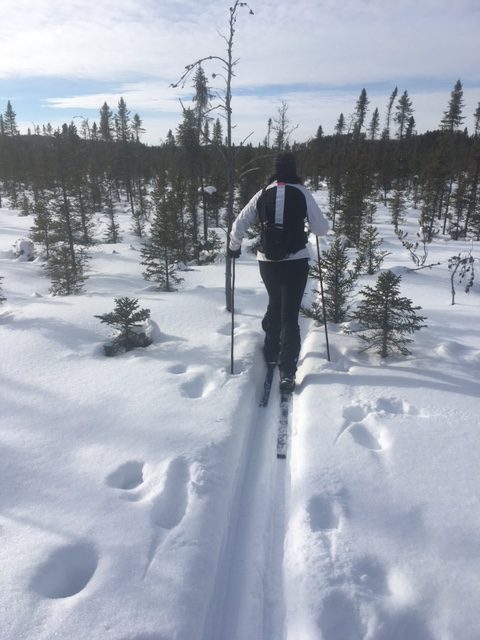

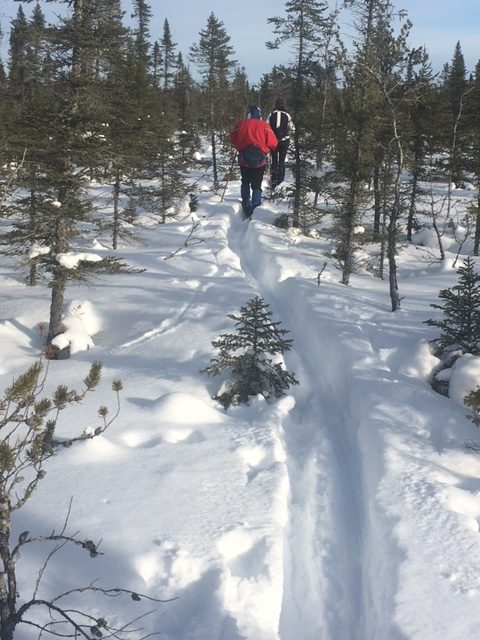



Christmas Bird Count December 18, 2021
Late migrants and well stocked bird feeders made for a fun bird count on December 18th. The Fort Frances Christmas Bird Count turned up 32 species, 7 seasoned field birdwatchers and 13 feeder watchers. Henry Miller, Mike Hammond, Bob Saunders, Randy Spritt, Henry Van Ael, Ilka Milne and Robyn Lloyd covered the field routes, with a combined total of 280 km by car and 16 km on foot, while 13 feeder watchers and walkers put in 34 hours of birdwatching.
In spite some interesting late migrants in the area, we all missed seeing any Canada Geese or Mallards. Also missed, in spite of evidence of it hunting around several feeders: the butcher bird, Northern Shrike. No owls were recorded either, making the species total of 32 a pretty good day. Often when we top 30 species it is because owls have moved into the area because of a prey crash further north.
The late migrants of interest are the Gray Catbird, seen by a feeder watcher in Couchiching, and American Robin, Dark-eyed Juncos, Bufflehead and Common Grackle – all seen in town by various observers. Gray Catbirds are near the northern summer limit of their range here, and overwinter along the gulf coast up to the southern part of the eastern sea board in the US. Accordingly, our late migrant is feeling chilly and apparently comes out to sun itself only on the finest days. At this writing it was last seen several days before count day. American Robins overwinter in the US and southern BC. Our December Robins usually are found near fruit trees and warm yards. Dark-eyed Juncos are small sparrow-like seed eaters who overwinter mainly in the eastern US, but in milder early and late winter we do often see them here. Common Grackles overwinter in the eastern US south of the Great Lakes typically, but we see them in December counts about as frequently as Robins. Buffleheads are small diving ducks who overwinter on the coasts and southern US. We’ve only seen them twice since 1995, and the last time was in 2005. We had a report of a Northern Cardinal in Emo the week before the count.
The Northern Goshawk, observed by a walker on the 8th Street Trails, is a year-round resident forest-dwelling hawk. It is rarely seen near town as it is more typical of large mature forested areas. Unlike the more usually seen Cooper’s Hawk and Kestrel (both significantly farther south at this time of year), the Northern Goshawk takes larger prey such as grouse and hare. Most other species counts were within previous limits, but the Hairy Woodpecker and American Crow both established new highs.
Any birdwatchers who would like to share their observations we encourage to try eBird. You can log online or download it to your phone and contribute your sightings, whether you occasionally see something interesting or are a daily watcher. You can choose your privacy settings, use the service simply as a place to store and share data or learn about birds others are seeing.
Participants
Mike Hammond
Irene Hill-Haver
Robyn Lloyd
Len McCormick
Ilka Milne
Kendall Richardson
Bob Saunders
Connie Schwartz
Dave Schwartz
Randall Spritt
Henry Van Ael
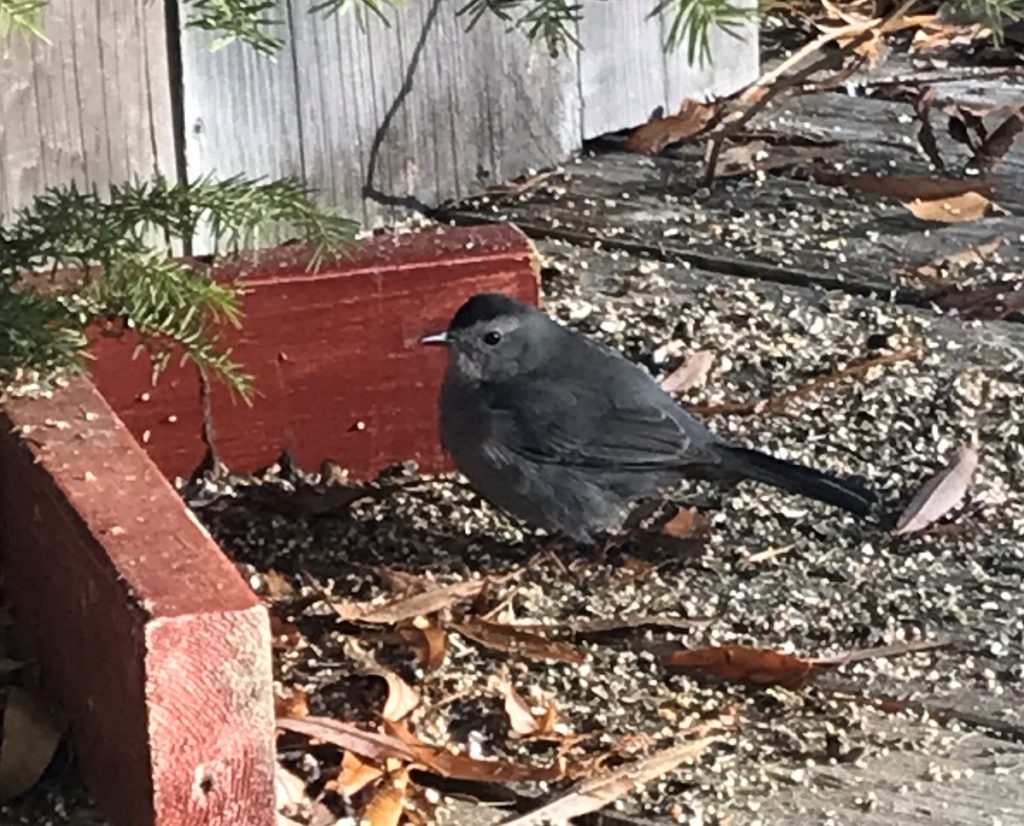
Bufflehead 1
Common Goldeneye 19
Ruffed Grouse 8
Sharp-tailed Grouse 58
Northern Goshawk 1
Bald Eagle 36
Rock Pigeon 117
Downy Woodpecker 19
Hairy Woodpecker 32
Northern Flicker 2
Pileated Woodpecker 1
Canada Jay 17
Blue Jay 67
Black-billed Magpie 38
American Crow 281
Common Raven 249
Black-capped Chickadee 417
Red-breasted Nuthatch 23
White-breasted Nuthatch 18
American Robin 1
Gray Catbird 1 (count week)
European Starling 248
Bohemian Waxwing 25
Cedar Waxwing 3
Snow Bunting 20
Dark-eyed Junco 6
Common Grackle 1
Pine Grosbeak 233
White-winged Crossbill 6
Common Redpoll 292
American Goldfinch 4
Evening Grosbeak 56
House Sparrow 106

